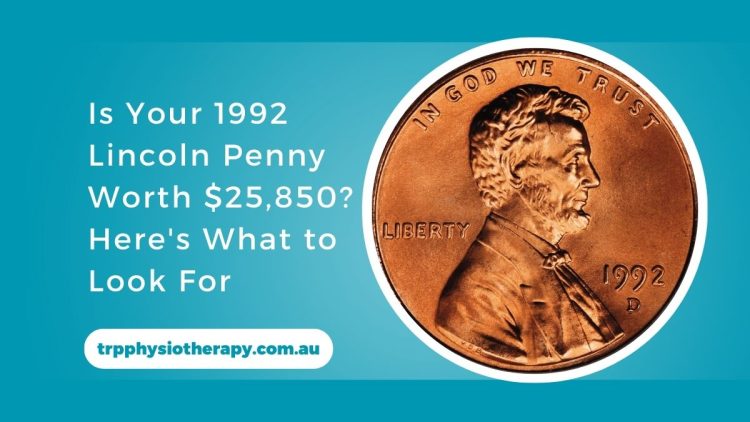The 1992 Lincoln penny, though commonly found in circulation, has captivated the attention of coin collectors and enthusiasts due to certain rare variations and errors that can significantly enhance its value.
While most 1992 pennies hold only their face value of one cent, specific errors have been known to fetch prices as high as $25,850.
In this comprehensive guide, we’ll delve into the distinguishing features that make these pennies valuable and provide detailed information on how to identify them.
Understanding the 1992 Lincoln Penny
The 1992 penny features Abraham Lincoln on the obverse and the Lincoln Memorial on the reverse. It’s composed of 97.5% zinc and 2.5% copper, weighing 2.5 grams with a diameter of 19.5 millimeters.
Over 9.1 billion of these pennies were minted, making them common in circulation. However, certain errors and variations can make specific coins highly valuable.
Key Variations and Errors
1. Close AM vs. Wide AM
A notable distinction in the 1992 penny is the spacing between the letters “A” and “M” in “AMERICA” on the reverse. The standard “Wide AM” variety has noticeable space between these letters.
In contrast, the rare “Close AM” variety features letters that are nearly touching. This rare variation can significantly increase a penny’s value, with some specimens selling for over $25,000.
Comparison of Wide AM and Close AM:
| Variety | Description | Value Range |
|---|---|---|
| Wide AM | Noticeable space between ‘A’ and ‘M’ | Face value to $5 |
| Close AM | Letters ‘A’ and ‘M’ nearly touching | $1,000 to $25,000+ |
2. Doubled Die Errors
Doubled die errors occur when the coin’s design is stamped multiple times, resulting in a doubled appearance of letters and numbers.
On a 1992 penny, this can manifest as doubled inscriptions on the obverse or reverse. Coins with noticeable doubling can be valuable, depending on the severity and location of the error.
Identifying Doubled Die Errors:
- Obverse Doubling: Look for doubled letters in “LIBERTY” or the date “1992.”
- Reverse Doubling: Check for doubled inscriptions in “E PLURIBUS UNUM” or the denomination “ONE CENT.”
3. Die Deterioration Doubling (DDD)
Die Deterioration Doubling arises from wear and tear on the minting die, leading to a slight distortion of the coin’s design. Unlike true doubled dies, DDD presents as a soft, wavy distortion, often mistaken for genuine doubling.
While it doesn’t significantly increase a coin’s value, it’s essential for collectors to differentiate it from authentic errors.
Distinguishing DDD from True Doubling:
- Appearance: DDD appears as a soft, wavy distortion without clear secondary images, whereas true doubling shows a crisp secondary image.
- Location: DDD typically affects the date and mintmark, while true doubling can affect various design elements.
4. Other Notable Errors
Additional errors include die cracks, off-center strikes, and misaligned dies. For instance, die cracks can cause raised lines on the coin’s surface, while off-center strikes result in designs that are not properly aligned. While these errors are less common, they can add unique characteristics to a penny, potentially enhancing its value.
Common Minting Errors:
- Die Cracks: Raised lines or “cuds” on the coin’s surface caused by cracks in the die.
- Off-Center Strikes: Design elements that are not properly aligned due to misalignment during minting.
- Misaligned Dies: Designs that appear shifted or doubled due to improper die alignment.
Identifying Valuable 1992 Pennies
To determine if your 1992 penny might be valuable:
- Examine the Reverse: Check the spacing between the “A” and “M” in “AMERICA” to identify Close AM varieties.
- Inspect for Doubling: Use a magnifying glass to look for doubled letters or numbers, especially in the inscriptions.
- Assess the Condition: Coins in excellent condition (graded as MS65 or higher) are more valuable.
- Consult Experts: If you suspect your penny has unique features, consider having it evaluated by a professional numismatist.
FAQs
How can I tell if my 1992 penny is a Close AM variety?
Examine the reverse of the penny, focusing on the spacing between the “A” and “M” in “AMERICA.” If the letters are nearly touching, it’s likely a Close AM variety.
What is the value of a standard 1992 penny?
A standard 1992 penny in circulated condition is worth its face value of one cent.
Are doubled die errors common in 1992 pennies?
While some doubled die errors are found in 1992 pennies, they are not exceedingly common. Coins with noticeable doubling can be valuable.
How can I differentiate between Die Deterioration Doubling and true doubling?
DDD appears as a soft, wavy distortion without clear secondary images, whereas true doubling shows a crisp secondary image.

